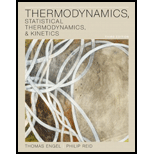
(a)
Interpretation: The largest mass lifted through a height h in the expression needs to be determined.
Concept Introduction: The change in internal energy is calculated as follows:
Here, n is number of moles,
The work done is represented as follows:
Here, P is external pressure and
The enthalpy of a reaction is represented as follows:
Here, n is number of moles, R is Universal gas constant and
(b)
Interpretation: The smallest mass that must fall through the height in order to restore the system needs to be determined.
Concept Introduction: The change in internal energy is calculated as follows:
Here, n is number of moles,
The work done is represented as follows:
Here, P is external pressure and
The enthalpy of a reaction is represented as follows:
Here, n is number of moles, R is Universal gas constant and
Interpretation: The values of masses needs to be calculate in part (a) and (b).
Concept Introduction: The change in internal energy is calculated as follows:
Here, n is number of moles,
The work done is represented as follows:
Here, P is external pressure and
The enthalpy of a reaction is represented as follows:
Here, n is number of moles, R is Universal gas constant and
Want to see the full answer?
Check out a sample textbook solution
Chapter 2 Solutions
Thermodynamics, Statistical Thermodynamics, & Kinetics
- What are the numerical values of the heat capacities c-v and c-p of a monatomic ideal gas,in units of cal/mol.K and L.atm/mol.K?arrow_forwardDetermine an expression for V/T p, n in terms of and . Does the sign on the expression make sense in terms of what you know happens to volume as temperature changes?arrow_forwardThe Dieterici equation of state for one mole of gas is p=RTe-aVRTV-b Where a and b are constants determined experimentally. For NH3g, a = 10.91 atm. L2 and b = 0.0401 L. Plot the pressure of the gas as the volume of 1.00 mol of NH3g expands from 22.4 L to 50.0 L at 273 K, and numerically determine the work done by the gas by measuring the area under the curve.arrow_forward
- What if we assumed that the heat capacity of gaseous NH3 is NOT dependent on temperature? Calculate the energy per mole required to be removed from gaseous NH3 from decrease the temperature of the system from 400 °C to 25 ºC. Assume that the heat capacity, Cpm, of NH3 is a constant over the temperature range considered and can be found in Table 2C.7arrow_forwardP3A.2 A sample consisting of 0.10 mol of perfect gas molecules is held by a piston inside a cylinder such that the volume is 1.25 dm²; the external is constant at 1.00 bar and the temperature is maintained at 300 Kby a thermostat. The piston is released so that the gas can expand. Calculate (a) the volume of the gas when the expansion is complete; (b) the work done when the gas expands; (c) the heat absorbed by the system. Hence calculate ASor pressurearrow_forwardCalculate V−1(∂V/∂T)p,n for an ideal gas?arrow_forward
- Two ideal gas systems undergo reversible expansion under different conditions starting from the same P and V. At the end of the expansion, both systems have the same volume, but one has a lower pressure than the other. Provide an explanation for this difference by describing how the two processes could have differed.arrow_forwardA sample consisting of 0.10 mol of perfect gas molecules is held by a piston inside a cylinder such that the volume is 1.25 dm3; the external pressure is constant at 1.00 bar and the temperature is maintained at 300 K by a thermostat. The piston is released so that the gas can expand. Calculate (a) the volume of the gas when the expansion is complete; (b) the work done when the gas expands; (c) the heat absorbed by the system. Hence calculate ΔStot.arrow_forwardwhere a and b are constants. Find V RT a+bT 2) The equation of state of a certain gas is given by p : aV Vm ),arrow_forward
- Suppose that a gas obeys at low pressure the equation T + (A + B) P PV = RT + A + where A and Bare constants independent of pressure and temperature, and Vis the molar vo Derive the expression for the change in enthalpy which will accompany the expansion of n moles from a pressure P,to a pressure P, at temperature T. Use this principle. Он OP T T (OT), P = V - Tarrow_forwardthe ionic compound L2O3(s) is the ionic compound formed from oxygen and a metal with the form L(s) at 1.00 bar and 298 K. (a) Draw the Lewis structure for L2O3. Assume that all the valence electrons from L are required. (b) Use the following information to determine the enthalpy of formation for L2O3(s). Express your answer in kJZ(mol L2O3(s)). Lattice energy for L2O3(s) = -14836 kJ mol1 AHsub for L(s) = 358 kJ mol 1 First ionization energy for L(g) = 577 kJ mol 1 Second ionization energy for L(g) = 1794 kJ mol 1 Third ionization energy for L(g) = 3820 kJ mol 1 Bond dissociation energy for O2(g) = 498 kJ mol 1 %3D First electron affinity for O = -141 kJ mol 1 Second electron affinity for O = 744 kJ mol 1arrow_forwardWhat would be the final volume occupied by 1.0 mol of an ideal gas initially at 0°C and 1.0 bar if Q = 1000J during a reversible isothermal expansion?arrow_forward
 Physical ChemistryChemistryISBN:9781133958437Author:Ball, David W. (david Warren), BAER, TomasPublisher:Wadsworth Cengage Learning,
Physical ChemistryChemistryISBN:9781133958437Author:Ball, David W. (david Warren), BAER, TomasPublisher:Wadsworth Cengage Learning, Chemistry: Principles and ReactionsChemistryISBN:9781305079373Author:William L. Masterton, Cecile N. HurleyPublisher:Cengage Learning
Chemistry: Principles and ReactionsChemistryISBN:9781305079373Author:William L. Masterton, Cecile N. HurleyPublisher:Cengage Learning

